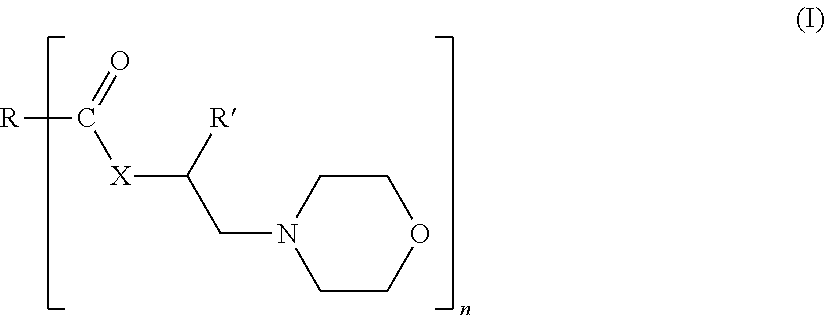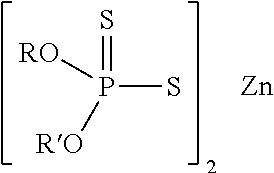Morpholine derivatives as ashless TBN sources and lubricating oil compositions containing same
a technology of morpholine derivatives and tbn, which is applied in the field of compounds, can solve the problems of oxidation catalyst poisoning, less effective, and claim that such lubricants will provide sufficient tbn, and achieve the effect of reducing the number of oxidation catalysts
- Summary
- Abstract
- Description
- Claims
- Application Information
AI Technical Summary
Benefits of technology
Problems solved by technology
Method used
Image
Examples
synthesis example 1.1
[0080]44.2 moles of iso-stearic acid and 1.25 eq. of 4-(2-hydroxyethyl)morpholine or HEM were charged into a 4-neck 30 L glass reactor equipped with a mechanical stirrer, condenser / Dean-Stark trap, and inlets for nitrogen. The reaction mixture was heated to 190° C.), and maintained at that temperature for 10 to 15 hours. After completion of the reaction, excess 4-(2-hydroxyethyl)morpholine was distilled off using a rotary evaporator, with full vacuum, at 160° C. The final product was characterized by NMR, total acid number titration (ASTM D-664), total base number titration (ASTM D-4739 and D-2896) and GC analysis.
synthesis example 1.2
[0081]0.58 moles of Floradyme™ 1500 (organic dimer acid available from Florachem Corp.) and 2.5 eq. of 4-(2-hydroxyethyl)morpholine or HEM were charged into a 4-neck 30 L glass reactor equipped with a mechanical stirrer, condenser / Dean -Stark trap, and inlets for nitrogen. The reaction mixture was heated to 190° C.), and maintained at that temperature for 10 to 15 hours. After completion of the reaction, excess 4-(2-hydroxyethyl)morpholine was distilled off using a rotary evaporator, with full vacuum, at 160° C. The final product was characterized by NMR, total acid number titration (ASTM D-664), total base number titration (ASTM D-4739 and D-2896) and GC analysis.
synthesis example 1.3
[0082]44.2 moles of Floradyme™ 6500 (organic trimer acid available from Florachem Corp.) and 4 eq. of 4-(2-hydroxyethyl)morpholine or HEM were charged into a 4-neck 30 L glass reactor equipped with a mechanical stirrer, condenser / Dean-Stark trap, and inlets for nitrogen. The reaction mixture was heated to 190° C.), and maintained at that temperature for 10 to 15 hours. After completion of the reaction, excess 4-(2-hydroxyethyl)morpholine was distilled off using a rotary evaporator, with full vacuum, at 160° C. The final product was characterized by NMR, total acid number titration (ASTM D-664), total base number titration (ASTM D-4739 and D-2896) and GC analysis.
[0083]The general reaction scheme for the above-synthesis is shown below:
[0084]
TBN Performance
[0085]The basicity of a lubricating oil composition can be determined by acid titration. The resulting neutralization number is expressed as total base number, or TBN, and can be measured using various methods. Two methods conventio...
PUM
| Property | Measurement | Unit |
|---|---|---|
| mass % | aaaaa | aaaaa |
| mass % | aaaaa | aaaaa |
| mass % | aaaaa | aaaaa |
Abstract
Description
Claims
Application Information
 Login to View More
Login to View More - R&D
- Intellectual Property
- Life Sciences
- Materials
- Tech Scout
- Unparalleled Data Quality
- Higher Quality Content
- 60% Fewer Hallucinations
Browse by: Latest US Patents, China's latest patents, Technical Efficacy Thesaurus, Application Domain, Technology Topic, Popular Technical Reports.
© 2025 PatSnap. All rights reserved.Legal|Privacy policy|Modern Slavery Act Transparency Statement|Sitemap|About US| Contact US: help@patsnap.com



